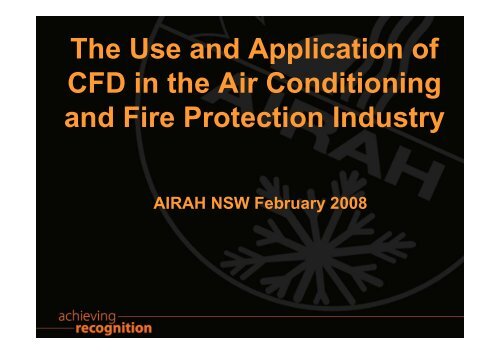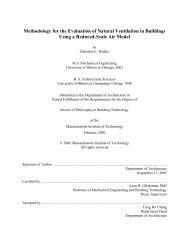The Use and Application of CFD in the Air Conditioning and ... - Cham
The Use and Application of CFD in the Air Conditioning and ... - Cham
The Use and Application of CFD in the Air Conditioning and ... - Cham
Create successful ePaper yourself
Turn your PDF publications into a flip-book with our unique Google optimized e-Paper software.
<strong>The</strong> <strong>Use</strong> <strong>and</strong> <strong>Application</strong> <strong>of</strong><strong>CFD</strong> <strong>in</strong> <strong>the</strong> <strong>Air</strong> Condition<strong>in</strong>gSem<strong>in</strong>ar<strong>and</strong> Fire Protection IndustryAIRAH NSW February 2008
<strong>The</strong> <strong>Use</strong> <strong>and</strong> <strong>Application</strong> <strong>of</strong> <strong>CFD</strong> <strong>in</strong> <strong>the</strong> <strong>Air</strong>Condition<strong>in</strong>g <strong>and</strong> Fire Protection IndustrySem<strong>in</strong>arAn Introduction to <strong>CFD</strong>Modell<strong>in</strong>g us<strong>in</strong>gPHOENICSBy Dr John LudwigConcentrated Heat <strong>and</strong> Momentum UK
What does CHAM do?Sem<strong>in</strong>ar“Simulation <strong>of</strong> processes <strong>in</strong>volv<strong>in</strong>g fluid flow,heat transfer, chemical reaction &combustion with<strong>in</strong> eng<strong>in</strong>eer<strong>in</strong>g equipment<strong>and</strong> <strong>the</strong> environment”A-Z <strong>in</strong>dustrial & environmentalapplicationsPractical - Cost-effective - Validated- Easy to <strong>Use</strong>
A wide range <strong>of</strong> applicationsSem<strong>in</strong>arSmoke & fire spreadHeat<strong>in</strong>g & VentilationAerodynamicsImpeller pump efficiency
A wide range <strong>of</strong> applicationsSem<strong>in</strong>arHeat transferMulti-phaseParticle track<strong>in</strong>g
Ma<strong>in</strong> Features <strong>of</strong> PHOENICSSem<strong>in</strong>ar• 1-,2- <strong>and</strong> 3-D geometries• Cartesian, Polar <strong>and</strong> Body-Fitted Coord<strong>in</strong>ates• Local multi-level f<strong>in</strong>e-grid embedd<strong>in</strong>g• Cut-cell technique for complex geometry• Conjugate Heat Transfer• S<strong>in</strong>gle or Multi-Phase Flow• Particle Track<strong>in</strong>g• Chemical reaction• Radiation• Non-Newtonian Flow• Choice <strong>of</strong> equation solvers <strong>and</strong> differenc<strong>in</strong>g schemes• Run-time implementation <strong>of</strong> user code – no recompil<strong>in</strong>g• Automatic convergence control
Ma<strong>in</strong> Features <strong>of</strong> PHOENICSSem<strong>in</strong>ar• PHOENICS consists <strong>of</strong> several modules:– VR-Editor for sett<strong>in</strong>g up problems,– EARTH for solv<strong>in</strong>g <strong>the</strong> problem,– VR-Viewer for visualis<strong>in</strong>g results; <strong>and</strong>– POLIS for provid<strong>in</strong>g <strong>in</strong>formation.• Toge<strong>the</strong>r <strong>the</strong>y allow users to solve a wide range <strong>of</strong> 1D, 2D <strong>and</strong>3D fluid flows simultaneously with heat transfer <strong>and</strong> chemicalreaction.
PHOENICS Key ComponentsSem<strong>in</strong>ar• Model setup – VR Editor• Click<strong>in</strong>g on anobject br<strong>in</strong>gs adialogue box onto<strong>the</strong> screen.• This enables <strong>the</strong><strong>in</strong>formation about<strong>the</strong> object to beedited.
PHOENICS Key ComponentsSem<strong>in</strong>ar• Model setup – VR Editor• <strong>The</strong> object geometrycan be taken from alibrary <strong>of</strong> shapes, orloaded from a CADfile.• CAD geometries areread us<strong>in</strong>g <strong>the</strong> STLformat
Analysis <strong>of</strong> Results - VR ViewerSem<strong>in</strong>ar<strong>The</strong> VR Viewer allows users to see <strong>the</strong>ir results <strong>in</strong> a number <strong>of</strong>different ways:
Analysis <strong>of</strong> Results - VR ViewerSem<strong>in</strong>arStreaml<strong>in</strong>es, static or animatedIso-surfacesContour planesVectors
What is FLAIR?Sem<strong>in</strong>ar• FLAIR is a Special-Purpose version <strong>of</strong> <strong>the</strong> general<strong>CFD</strong> code PHOENICS.• It is aimed at <strong>the</strong> HVAC community.• It has been created by remov<strong>in</strong>g many unneededgeneric features, <strong>and</strong> add<strong>in</strong>g several specificfeatures.
FLAIR FeaturesSem<strong>in</strong>ar• FLAIR uses <strong>the</strong> PHOENICS VR-Editor to set <strong>the</strong>problem up, with <strong>the</strong> follow<strong>in</strong>g additional items:– ISO 7730 Comfort <strong>in</strong>dex calculations: PMV, PPD.– ISO 7730 Draught rat<strong>in</strong>g.– CIBSE dry resultant temperature.– Humidity calculations, with output <strong>of</strong> humidity ratio <strong>and</strong>relative humidity.– Smoke movement calculation, with output <strong>of</strong> PPM, smokedensity <strong>and</strong> visibility.– Mean age <strong>of</strong> air calculation.– Fan operat<strong>in</strong>g po<strong>in</strong>t calculation for s<strong>in</strong>gle <strong>and</strong> multiple fans.– System-curve calculations.
FLAIR FeaturesSem<strong>in</strong>ar• In addition, <strong>the</strong> follow<strong>in</strong>g object types have been added:– DiffuserRound
FLAIR FeaturesSem<strong>in</strong>ar• In addition, <strong>the</strong> follow<strong>in</strong>g object types have been added:– DiffuserVortex
FLAIR FeaturesSem<strong>in</strong>ar• In addition, <strong>the</strong> follow<strong>in</strong>g object types have been added:– DiffuserRectangular
FLAIR FeaturesSem<strong>in</strong>ar• In addition, <strong>the</strong> follow<strong>in</strong>g object types have been added:– DiffuserDirectional
FLAIR FeaturesSem<strong>in</strong>ar• In addition, <strong>the</strong> follow<strong>in</strong>g object types have been added:– DiffuserGrille
FLAIR FeaturesSem<strong>in</strong>ar• In addition, <strong>the</strong> follow<strong>in</strong>g object types have been added:– DiffuserDisplacement
FLAIR FeaturesSem<strong>in</strong>ar• In addition, <strong>the</strong> follow<strong>in</strong>g object types have been added:– Diffuser– Fire
FLAIR FeaturesSem<strong>in</strong>ar• In addition, <strong>the</strong> follow<strong>in</strong>g object types have been added:– Diffuser– Fire– Person (st<strong>and</strong><strong>in</strong>gor sitt<strong>in</strong>g fac<strong>in</strong>g anyDirection)
FLAIR FeaturesSem<strong>in</strong>ar• In addition, <strong>the</strong> follow<strong>in</strong>g object types have been added:– Diffuser– Fire– Person– CrowdTo represent a large number <strong>of</strong> people as distributed source <strong>of</strong> heat
FLAIR FeaturesSem<strong>in</strong>ar• In addition, <strong>the</strong> follow<strong>in</strong>g object types have been added:– Diffuser– Fire– Person– Crowd– SunlightCreated <strong>in</strong>Shapemaker
FLAIR FeaturesSem<strong>in</strong>ar• In addition, <strong>the</strong> follow<strong>in</strong>g object types have been added:– Diffuser– Fire– Person– Crowd– Sunlight– Spray head
FLAIR FeaturesSem<strong>in</strong>ar• Spray-head represents spr<strong>in</strong>klers user for fire-suppression.• It uses GENTRA to model <strong>the</strong> droplet paths.• Evaporation is considered, <strong>and</strong> is l<strong>in</strong>ked to <strong>the</strong> FLAIRhumidity model.• <strong>The</strong> GENTRA <strong>in</strong>let table iswritten automatically.
FLAIR FeaturesSem<strong>in</strong>ar• In addition, <strong>the</strong> follow<strong>in</strong>g object types have been added:– Diffuser– Fire– Person– Crowd– Sunlight– Spray head– Jet fan
Example Case StudiesSem<strong>in</strong>ar<strong>The</strong> follow<strong>in</strong>g <strong>Application</strong> Examples will beshown:• Car Park Safety• Office Build<strong>in</strong>g Ventilation• External flow over build<strong>in</strong>gs
Sem<strong>in</strong>arPHOENICSCarpark Example
Car Park• This work was carried out as a Consultancy model-build <strong>in</strong>support <strong>of</strong> Excel<strong>Air</strong> BV <strong>in</strong> Holl<strong>and</strong>.Sem<strong>in</strong>ar• It concerns <strong>the</strong> spread <strong>of</strong> smoke through a complex car parkas a result <strong>of</strong> a car fire on one <strong>of</strong> <strong>the</strong> lower floors.• <strong>The</strong> car park is spiral <strong>in</strong> form, with an open centre.• <strong>The</strong> car fire is 8.3 MW. After 180s, spr<strong>in</strong>klers on <strong>the</strong> floorwhere <strong>the</strong> fire is are activated.
Car Park - Geometry• Ro<strong>of</strong> <strong>in</strong> placeSem<strong>in</strong>ar
Car Park - Geometry• Ro<strong>of</strong> removedSem<strong>in</strong>ar
Car Park - Geometry• Ro<strong>of</strong>, lift shafts <strong>and</strong> first floor removedSem<strong>in</strong>ar
Car Park - Geometry• More floors removedSem<strong>in</strong>ar
Car Park - Geometry• Fire <strong>and</strong> spr<strong>in</strong>klers on lowest floorSem<strong>in</strong>ar
Car Park - Geometry• Spr<strong>in</strong>klers activatedSem<strong>in</strong>ar
Car Park - Spr<strong>in</strong>klers• Close-up <strong>of</strong> spr<strong>in</strong>klersSem<strong>in</strong>ar
Car Park - Spr<strong>in</strong>klers• Close-up <strong>of</strong> spr<strong>in</strong>klersSem<strong>in</strong>ar
Car Park - TemperatureSem<strong>in</strong>ar• This slide shows <strong>the</strong> temperature contours <strong>in</strong> a plane near <strong>the</strong>fire after 400s.• <strong>The</strong> high temperatures are ma<strong>in</strong>ly on <strong>the</strong> floor with <strong>the</strong> fire.
Car Park - Visibility• Sight length after 400s. This is <strong>the</strong> distance you can see. 30m isassumed to be <strong>in</strong>f<strong>in</strong>itely far.Sem<strong>in</strong>ar• <strong>The</strong> visibility near <strong>the</strong> fire is poor,
PHOENICS applied to Steady-stateSimulations <strong>of</strong> <strong>the</strong> Internal Flowwith<strong>in</strong> a Multi-storey Build<strong>in</strong>gSem<strong>in</strong>ar
IntroductionSem<strong>in</strong>ar• CHAM’s Consultancy Team used PHOENICS/FLAIRfor <strong>the</strong> analysis <strong>of</strong> a multi-storey build<strong>in</strong>g <strong>in</strong> <strong>the</strong> Kistaregion <strong>of</strong> Stockholm, Sweden.• A model was created for test<strong>in</strong>g <strong>the</strong> <strong>in</strong>ternaltemperature distribution when subjected to worstcasew<strong>in</strong>ter <strong>and</strong> summer conditions (i.e. very cold orvery hot).
IntroductionSem<strong>in</strong>ar• <strong>The</strong>re was concern about:– <strong>the</strong> production <strong>of</strong> colddowndrafts <strong>in</strong> <strong>the</strong> atrium oralong <strong>the</strong> large glassedfaçades dur<strong>in</strong>g <strong>the</strong> w<strong>in</strong>ter– whe<strong>the</strong>r <strong>the</strong>re were regions<strong>of</strong> unacceptably high airtemperature dur<strong>in</strong>g <strong>the</strong>summer time.
IntroductionSem<strong>in</strong>ar• <strong>The</strong> build<strong>in</strong>g design was supplied <strong>in</strong> <strong>the</strong> form <strong>of</strong> anumber <strong>of</strong> AutoCAD.DWG (Draw<strong>in</strong>g) files <strong>of</strong> <strong>the</strong>build<strong>in</strong>g <strong>and</strong> its location, along with <strong>the</strong> operationalboundary data, such as:– <strong>the</strong> glass specification,– <strong>the</strong> build<strong>in</strong>g material,– <strong>in</strong>ternal heat sources, toge<strong>the</strong>r with an estimate <strong>of</strong> <strong>the</strong> number<strong>of</strong> people, <strong>and</strong> supplementary heat<strong>in</strong>g <strong>and</strong> cool<strong>in</strong>g baffles.
Geometry CreationSem<strong>in</strong>ar• Eight <strong>of</strong>fices are located on four floors on ei<strong>the</strong>r side<strong>of</strong> <strong>the</strong> atrium.• AC3D was used to create ‘bespoke’ objects for <strong>the</strong><strong>of</strong>fice floor
Geometry CreationSem<strong>in</strong>ar• Included with<strong>in</strong> <strong>the</strong> model are some 650 objectsrepresent<strong>in</strong>g doors, walls, ro<strong>of</strong>, ceil<strong>in</strong>gs, glassw<strong>in</strong>dows, computers, persons, <strong>of</strong>fice furniture <strong>and</strong>various types <strong>of</strong> heat-sources.• <strong>The</strong> distribution <strong>of</strong> <strong>the</strong>se objects <strong>in</strong> all <strong>of</strong>fices oneach floor is similar.
Geometry CreationSem<strong>in</strong>ar• Once one floor had been created, <strong>the</strong> ‘Array Copy’feature was used to quickly generate <strong>the</strong> rema<strong>in</strong><strong>in</strong>gfloors.
Problem SpecificationSem<strong>in</strong>ar• To represent summertime conditions, a total solarheat ga<strong>in</strong> <strong>of</strong> 46,580 Watts is specified through <strong>the</strong>glass doors <strong>and</strong> w<strong>in</strong>dows, with <strong>the</strong> radiationprojected onto <strong>the</strong> floors <strong>and</strong> <strong>in</strong>ternal walls.• This is <strong>in</strong> addition to <strong>the</strong> normal heat generated bypeople <strong>in</strong> <strong>the</strong> conference room <strong>and</strong> <strong>of</strong>fices, <strong>and</strong> bylights <strong>and</strong> mach<strong>in</strong>es <strong>in</strong>side <strong>the</strong> build<strong>in</strong>g.• <strong>The</strong> temperature with<strong>in</strong> <strong>the</strong> build<strong>in</strong>g is regulated byan air condition<strong>in</strong>g system <strong>in</strong>troduc<strong>in</strong>g cooled air at15°C, <strong>and</strong> a ventilation system generat<strong>in</strong>g a total airexchange <strong>of</strong> 2300 l/s throughout <strong>the</strong> build<strong>in</strong>g.
Problem SpecificationSem<strong>in</strong>ar• <strong>The</strong> w<strong>in</strong>ter case differs <strong>in</strong> that <strong>the</strong>re is no solar heataffect<strong>in</strong>g <strong>the</strong> temperature <strong>in</strong> <strong>the</strong> build<strong>in</strong>g.• Due to <strong>the</strong> low temperature outside, <strong>the</strong> glass door<strong>and</strong> all <strong>the</strong> glass w<strong>in</strong>dows take heat away from <strong>the</strong>build<strong>in</strong>g.• <strong>The</strong> temperature <strong>of</strong> <strong>the</strong> ventilation air <strong>in</strong> <strong>the</strong> build<strong>in</strong>g is<strong>in</strong>creased from 15°C to 18°C.
ResultsSem<strong>in</strong>ar• A total mesh size <strong>of</strong> 1.1M cells (108 * 123 * 85) wasused, non-uniformly distributed over <strong>the</strong> entirecalculation doma<strong>in</strong>.
Results• A converged solution was obta<strong>in</strong>ed after 2000iterations, which took 22 hours to complete on a3MHz PC, <strong>and</strong> 8.5 hours on an equivalent 4-processor cluster us<strong>in</strong>g <strong>the</strong> parallel version <strong>of</strong>PHOENICS.Sem<strong>in</strong>ar
Results• Summer temperatures – X planeSem<strong>in</strong>ar
Results• W<strong>in</strong>ter temperatures – X planeSem<strong>in</strong>ar
Results• Summer temperatures – Y planeSem<strong>in</strong>ar
Results• W<strong>in</strong>ter temperatures – Y planeSem<strong>in</strong>ar
Results• Velocities <strong>in</strong> one <strong>of</strong> <strong>the</strong> roomsSem<strong>in</strong>ar
Results• Velocities <strong>in</strong> one <strong>of</strong> <strong>the</strong> roomsSem<strong>in</strong>ar
Results• Temperatures <strong>in</strong> one <strong>of</strong> <strong>the</strong> roomsSem<strong>in</strong>ar
Results• Temperatures <strong>in</strong> one <strong>of</strong> <strong>the</strong> roomsSem<strong>in</strong>ar
ConclusionSem<strong>in</strong>ar• <strong>The</strong>se, <strong>and</strong> more-detailed, results were supplied tosupport evidence from CHAM’s customer todemonstrate <strong>the</strong> effectiveness <strong>of</strong> <strong>the</strong> build<strong>in</strong>g’sHVAC design under atypical wea<strong>the</strong>r scenarios.
PHOENICS Applied to Large-scaleEnvironmental FlowsSem<strong>in</strong>ar
Large-scale EnvironmentalFlowsSem<strong>in</strong>ar• <strong>The</strong> work concerns localised environmental conditionswhich could affect <strong>the</strong> occupants <strong>of</strong> <strong>the</strong> build<strong>in</strong>gs aswell as pedestrians.
Large-scale EnvironmentalFlows• <strong>The</strong> objectives <strong>of</strong> this project are:Sem<strong>in</strong>ar– to <strong>in</strong>vestigate <strong>the</strong> <strong>in</strong>fluence <strong>of</strong> different w<strong>in</strong>d speeds <strong>and</strong>w<strong>in</strong>d directions on <strong>the</strong> air flow throughout <strong>the</strong> residentialarea;– to reveal any unusual w<strong>in</strong>d patterns that may cause suction<strong>and</strong> up- <strong>and</strong> down-drafts that could render podium, balcony,penthouse or terraced areas at lower or upper levelsdangerous to <strong>the</strong> residents.
Large-scale EnvironmentalFlowsSem<strong>in</strong>ar• In <strong>the</strong> past, such an <strong>in</strong>vestigation would have required:– <strong>the</strong> construction <strong>of</strong> a small-scale model <strong>of</strong> <strong>the</strong> proposedcomplex <strong>of</strong> build<strong>in</strong>gs,– plac<strong>in</strong>g <strong>the</strong> model <strong>in</strong> a w<strong>in</strong>d-tunnel, <strong>and</strong>– mak<strong>in</strong>g extensive measurements.• Nowadays, use <strong>of</strong> simulation techniques enables <strong>the</strong>same <strong>in</strong>formation to be obta<strong>in</strong>ed more swiftly, <strong>and</strong> atsmaller f<strong>in</strong>ancial cost.• CHAM has <strong>the</strong>refore employed its proprietary s<strong>of</strong>twarepackage, PHOENICS-FLAIR, to evaluate <strong>the</strong>aerodynamic implications <strong>of</strong> <strong>the</strong> CAD-filerepresentation <strong>of</strong> <strong>the</strong> Residential complex supplied by<strong>the</strong> client.
Large-scale EnvironmentalFlowsSem<strong>in</strong>ar• In <strong>the</strong> first stage <strong>of</strong> <strong>the</strong> work, reported here, <strong>the</strong>complex has been studied as a whole, <strong>in</strong> order that <strong>the</strong><strong>in</strong>fluences <strong>of</strong> one build<strong>in</strong>g on ano<strong>the</strong>r can be <strong>in</strong>cluded<strong>in</strong> <strong>the</strong> prediction.• In later stages it is proposed to study <strong>in</strong> f<strong>in</strong>er detailsuch <strong>in</strong>dividual build<strong>in</strong>gs, <strong>and</strong> parts <strong>of</strong> build<strong>in</strong>gs, as <strong>the</strong>first-stage study has shown to deserve fur<strong>the</strong>rattention.
Large-scale EnvironmentalFlows• Geometry <strong>and</strong> calculation doma<strong>in</strong>Sem<strong>in</strong>ar– <strong>The</strong> calculation doma<strong>in</strong> covers <strong>the</strong> entire area <strong>of</strong> 2939m x1300m, provided by <strong>the</strong> Client <strong>in</strong> a s<strong>in</strong>gle geometry file,<strong>in</strong>clud<strong>in</strong>g all <strong>the</strong> build<strong>in</strong>gs <strong>and</strong> surround<strong>in</strong>g areas.– <strong>The</strong> height <strong>of</strong> 302m from <strong>the</strong> ground <strong>in</strong> <strong>the</strong> vertical direction <strong>of</strong><strong>the</strong> calculation doma<strong>in</strong> provides about 100m open spaceabove <strong>the</strong> tallest build<strong>in</strong>g.
Large-scale EnvironmentalFlows• Physical modell<strong>in</strong>gSem<strong>in</strong>ar– Three-dimensional conservation equations are solved formass cont<strong>in</strong>uity <strong>and</strong> momentum.– <strong>The</strong> flow is steady.– <strong>The</strong> Cartesian co-ord<strong>in</strong>ate system is employed. A non-uniformmesh distribution is adopted with f<strong>in</strong>er meshes assignedaround <strong>the</strong> build<strong>in</strong>gs.– <strong>The</strong> grid used uses 208 x 167 X 46 cells.– Ground friction is considered.– <strong>The</strong> turbulence is represented by <strong>the</strong> LVEL turbulence modelbuilt <strong>in</strong>to PHOENICS.
Large-scale EnvironmentalFlows• Boundary conditionsSem<strong>in</strong>ar– A w<strong>in</strong>d pr<strong>of</strong>ile <strong>of</strong> U 1/7 with <strong>the</strong> measured w<strong>in</strong>d speed at aheight <strong>of</strong> 8m is employed at <strong>the</strong> boundaries where <strong>the</strong> w<strong>in</strong>denters <strong>the</strong> doma<strong>in</strong>.– In-Form is used to set <strong>the</strong> boundary layer pr<strong>of</strong>ile.
Large-scale EnvironmentalFlowsSem<strong>in</strong>ar• <strong>The</strong> results show that<strong>the</strong> predicted localisedw<strong>in</strong>d speed <strong>in</strong>creases as<strong>the</strong> <strong>in</strong>com<strong>in</strong>g w<strong>in</strong>d speed<strong>in</strong>creases <strong>and</strong> as <strong>the</strong>height from <strong>the</strong> ground<strong>in</strong>creases.• <strong>The</strong> maximum w<strong>in</strong>dspeed could reachover 200 kph.
Large-scale EnvironmentalFlowsSem<strong>in</strong>ar• In-Form was used to deduce <strong>the</strong> velocity <strong>in</strong> kph from<strong>the</strong> st<strong>and</strong>ard PHOENICS m/s.
<strong>The</strong> <strong>Use</strong> <strong>and</strong> <strong>Application</strong> <strong>of</strong><strong>CFD</strong> <strong>in</strong> <strong>the</strong> <strong>Air</strong> Condition<strong>in</strong>gSem<strong>in</strong>ar<strong>and</strong> Fire Protection IndustryAIRAH NSW February 2008

















